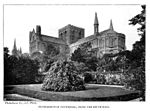
Oswald was King of Northumbria from 634 until his death, and is venerated as a saint, of whom there was a particular cult in the Middle Ages.

Edward, often called the Martyr, was King of the English from 975 until he was murdered in 978. Edward was the eldest son of King Edgar, but was not his father's acknowledged heir. On Edgar's death, the leadership of England was contested, with some supporting Edward's claim to be king and others supporting his younger half-brother Æthelred, recognised as a legitimate son of Edgar. Edward was chosen as king and was crowned by his main clerical supporters, the archbishops Dunstan of Canterbury and Oswald of York.
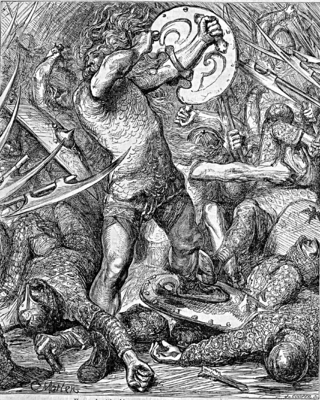
Hereward the Wake was an Anglo-Saxon nobleman and a leader of local resistance to the Norman Conquest of England. His base when he led the rebellion against the Norman rulers was the Isle of Ely, in eastern England. According to legend, he roamed the Fens, which covers parts of the modern counties of Cambridgeshire, Lincolnshire and Norfolk, and led popular opposition to William the Conqueror.
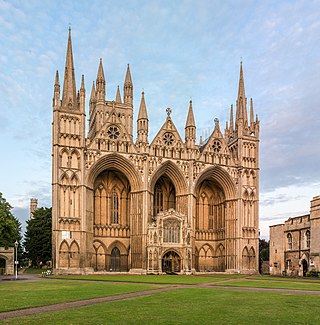
Peterborough Cathedral, properly the Cathedral Church of St Peter, St Paul and St Andrew – also known as Saint Peter's Cathedral in the United Kingdom – is the seat of the Anglican Bishop of Peterborough, dedicated to Saint Peter, Saint Paul and Saint Andrew, whose statues look down from the three high gables of the famous West Front. Although it was founded in the Anglo-Saxon period, its architecture is mainly Norman, following a rebuilding in the 12th century. With Durham and Ely cathedrals, it is one of the most important 12th-century buildings in England to have remained largely intact, despite extensions and restoration.

Edmund the Martyr was king of East Anglia from about 855 until his death.

The Peterborough Chronicle is a version of the Anglo-Saxon Chronicles originally maintained by the monks of Peterborough Abbey in Cambridgeshire. It contains unique information about the history of England and of the English language after the Norman Conquest; according to philologist J. A. W. Bennett, it is the only prose history in English between the Conquest and the later 14th century.

Ingulf was the Benedictine abbot of Crowland from 1087.

Cynesige was a medieval English Archbishop of York between 1051 and 1060. Prior to his appointment to York, he was a royal clerk and perhaps a monk at Peterborough. As archbishop, he built and adorned his cathedral as well as other churches, and was active in consecrating bishops. After his death in 1060, the bequests he had made to a monastery were confiscated by the queen.
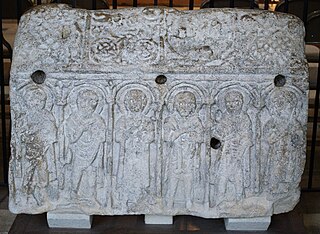
Medeshamstede was the name of Peterborough in the Anglo-Saxon period. It was the site of a monastery founded around the middle of the 7th century, which was an important feature in the kingdom of Mercia from the outset. Little is known of its founder and first abbot, Sexwulf, though he was himself an important figure, and later became bishop of Mercia. Medeshamstede soon acquired a string of daughter churches, and was a centre for an Anglo-Saxon sculptural style.

Thorney Abbey, now the Church of St Mary and St Botolph, was a medieval monastic house established on the island of Thorney in The Fens of Cambridgeshire, England.
Ælfric Cild was a wealthy Anglo-Saxon nobleman from the east Midlands, Ealdorman of Mercia between 983 and 985, and possibly brother-in-law to his predecessor Ælfhere. He was also associated with the monastic reformer Æthelwold, bishop of Winchester, he is also notable for being involved in a number of land transactions for the refounding and endowment of Peterborough Abbey, as well as with Thorney Abbey during the 970s and early 980s.
Æthelric was Bishop of Durham from 1041 to 1056 when he resigned.

Hugh Candidus was a monk of the Benedictine monastery at Peterborough, who wrote a Medieval Latin account of its history, from its foundation as Medeshamstede in the mid 7th century up to the mid 12th century.
Seaxwulf was the founding abbot of the Mercian monastery of Medeshamstede, and an early medieval bishop of Mercia. Very little is known of him beyond these details, drawn from sources such as Bede's Ecclesiastical History. Some further information was written down in the 12th century at Peterborough Abbey, as Medeshamstede was known by that time. This suggests that he began his career as a nobleman, and that he may have had royal connections outside Mercia.
Kyneburga, Kyneswide and Tibba were female members of the Mercian royal family in 7th century England who were venerated as saints.
Ælfgifu of Shaftesbury was the first wife of King Edmund I. She was Queen of the English from her marriage in around 939 until her death in 944. Ælfgifu and Edmund were the parents of two future English kings, Eadwig and Edgar. Like her mother Wynflaed, Ælfgifu had a close and special if unknown connection with the royal nunnery of Shaftesbury (Dorset), founded by King Alfred, where she was buried and soon revered as a saint. According to a pre-Conquest tradition from Winchester, her feast day is 18 May.

The Liber Eliensis is a 12th-century English chronicle and history, written in Latin. Composed in three books, it was written at Ely Abbey on the island of Ely in the fenlands of eastern Cambridgeshire. Ely Abbey became the cathedral of a newly formed bishopric in 1109. Traditionally the author of the anonymous work has been given as Richard or Thomas, two monks at Ely, one of whom, Richard, has been identified with an official of the monastery, but some historians hold that neither Richard nor Thomas was the author.

The Anglo-Saxon Chronicle is a collection of annals in Old English, chronicling the history of the Anglo-Saxons.
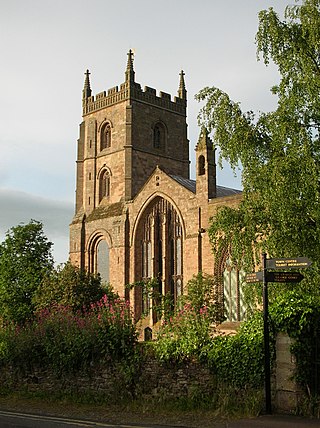
Eadfrith of Leominster also known as Eadridus was a seventh century Catholic saint from Anglo-Saxon England. Although very little is known of his early life, he is an important figure in the process of Christianisation of Anglo-Saxon England.
Saints Wulfhad and Ruffin were legendary 7th-century Christian martyrs from the royal family of Mercia. They were said to have been baptized by Saint Chad of Mercia, and their pagan father was said to have killed them at Stone, Staffordshire, England. Their feast day is 24 July.
